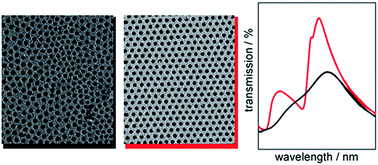Getting real: influence of structural disorder on the performance of plasmonic hole array sensors fabricated by a bottom-up approach†
Abstract
Hole arrays in gold films possessing different degrees of order were fabricated by a combination of colloidal lithography and chemical gold deposition. Here, hydrogel spheres were used for the formation of non-close packed microsphere arrays, which act as masks for subsequent gold film deposition. The assembly of the soft spheres into arrays possessing different degrees of order was controlled by the addition of alcohol and application of mechanical shear. The resulting hydrogel mask was translated into a hole array by functionalization of the glass surface with 3-aminopropyltriethoxysilane, deposition of gold nanoparticles and subsequent gold film growth by electroless deposition. The degree of order of the resulting nanostructures was thoroughly determined by analyzing SEM images and correlated with variations in their transmissive optical properties. In general the degree of order has a tremendous effect on the position of the transmission maxima of the hole arrays. This is not surprising, as deviations from the ideal hexagonal packing will lead to an increase of the lattice constant of the array, which determines the transmission peak positions. Hence, the transmission spectra can be employed for a spectral quality control of the order of the fabricated hole arrays in gold films. However, the sensing performance of the plasmonic hole arrays is only partly influenced by the degree of order. The impact of the degree of order of the hole array on its sensitivity is thus determined by the spectral feature used for sensing.

- This article is part of the themed collection: 2014 Journal of Materials Chemistry C Hot Articles

 Please wait while we load your content...
Please wait while we load your content...